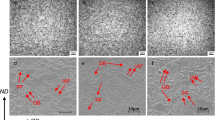Abstract
IT has been known for the past two decades that in the extrusion of lead cable sheaths and pipe on the hydraulic press, the presence of oxides may result in the existence of irregularities in the structure which are brought to light by suitably etching a polished section. In this case, the feature originates in the oxidation of a surface of the metal exposed at an earlier stage in the process, and the layer of oxide, formed at right angles to the direction of flow, may be folded over, and appear afterwards as a radial line of weakness in the finished pipe. An important distinguishing feature in this type of irregularity is the fact that the crystal structures on the two sides of the feature are quite separate and distinct; there is no growing of the crystals across the line of oxide (see Fig. 1).
This is a preview of subscription content, access via your institution
Access options
Subscribe to this journal
Receive 51 print issues and online access
$199.00 per year
only $3.90 per issue
Buy this article
- Purchase on Springer Link
- Instant access to full article PDF
Prices may be subject to local taxes which are calculated during checkout
Similar content being viewed by others
Author information
Authors and Affiliations
Rights and permissions
About this article
Cite this article
DUNSHEATH, P. A Lead Extrusion Phenomenon. Nature 139, 755–756 (1937). https://doi.org/10.1038/139755b0
Issue Date:
DOI: https://doi.org/10.1038/139755b0
This article is cited by
-
A Lead Extrusion Phenomenon
Nature (1937)
Comments
By submitting a comment you agree to abide by our Terms and Community Guidelines. If you find something abusive or that does not comply with our terms or guidelines please flag it as inappropriate.



